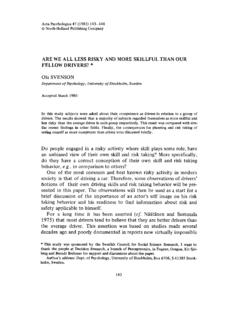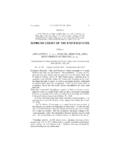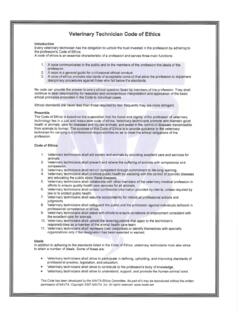Transcription of On the ethics of intervention in human psychological ...
1 On the ethics of intervention in human psychological research : With special reference to the Stanford prison experiment PHILIP G. ZIMBARDO. Stanford University research was conducted recently (August 14-21, 1971) in which subjects assumed the roles of prisoner' or guard' for an extended period of time within an experimentally devised mock prison setting on the Stanford University campus. The projected two- week study had to be prematurely terminated when it became apparent that many of the prisoners' were in serious distress and many of the guards' were behaving in ways which brutalized and degraded their fellow subjects. In addition, the emerging reality of this role-playing situation was sufficiently compelling to influence virtually all those who operated within it to behave in ways appropriate to its demand charac- teristics, but inappropriate to their usual life roles and values; this included the research staff, faculty observers, a priest, lawyer, ex-convict, and relatives and friends of the subjects who visited the prison on several occasions (for details see Zimbardo, Banks, Haney and Jaffe, 1973; Haney, Banks and Zimbardo, 1973).
2 This research represents one of the most extreme experimental demonstrations of the power of situational determinants in both shaping behaviour and predominating over personality, attitudes and individual values. As such it extends the conclusions from Stanley Milgram's research on obedience to authority (1974). But the ethical concerns voiced over Milgram's treatment of placing subject-teachers in a conflict situation where they believed (incorrectly) that they were hurting another person are even more pronounced in the present case. Volunteer prisoners suffered physical and psychological abuse hour after hour for days, while volunteer guards were exposed to the new self-knowledge that they enjoyed being powerful and had abused this power to make other human beings suffer.
3 The intensity and duration of this suffering uniquely qualify the Stanford prison experiment for careful scrutiny of violations of the ethics of human experimentation. The plan of this article is to: (a) Give a synopsis of the experiment to familiarize the reader with its basic features; (b) summarize one set of critical arguments levelled Cognition 2(2), pp. 243-256. 244 Philip G. Zimbardo against the experiment (which invited my reply in this particular journal); (c) analyze the sense in which the mock prison study can be considered to be unethical, and (d). present a body of information relevant to passing judgment on its ethicality from a legal, pragmatic, utilitarian or relativistic model of ethics .
4 My intention is less to assume a defensive stance in support of this particular study than to use it as a vehicle for delineating the enormous complexity of making ethically based decisions about interventions in human experimentation. Synopsis of mock prison study Interpersonal dynamics in a prison-like environment were studied experimentally by designing a functional (rather than literal) simulation of a prison. Environmental, structural, institutional and social variables were manipulated in an effort to create a psychology of imprisonment' in a group of subjects who role-played being guards (for eight hours a day over three shifts) and a group who acted as prisoners (for twenty- four hours a day).
5 To assess the strength of the social, situational forces on the behaviour of these volunteer subjects, alternative explanations in terms of pre-existing dispositions were eliminated through subject selection and random assignment to treatments. A homo- geneous sample of about two dozen normal, average, healthy American college males was chosen after extensive interviewing and diagnostic testing of a large group of applicants recruited through newspaper advertisements. The subjects were from colleges throughout the United States and Canada who volunteered to be in a study of prison life' in return for receiving a daily wage of tifteen dollars for a projected two-week period.
6 Half of these pre-selected subjects were randomly assigned to role-play prison guards, the others to the mock-prisoner treatment. Neither group received any formal training in these roles - the cultural mass media had already provided the models they used to define their roles. The mock guards were impressed with the seriousness' of the experiment and by the demeanor of the research staff; the prospective prisoners began to take their roles seriously when they were subjected to an unexpected arrest by the city police. After being processed and temporarily detained at the police station, they were escorted to the experimental setting. Uniforms and differences in power further served to differentiate the two groups of subjects.
7 Continuous, direct observation of all behavioural interactions was supplemented by video- and audio-taped recordings, questionnaires, self-report scales and inter- views. All of these data sources converge on the conclusion that this simulated en- vironment was sufficiently realistic and forceful to elicit intense, personal and often On the ethics of intervention in human psychological research 245. pathological reactions from the majority of the participants. Many of the prisoner- subjects exhibited behaviors characteristic of the learned helplessness syndrome described by Seligman (1973) in his research on traumatic, avoidance conditioning.
8 The guard-subjects displayed a behavioral profile which was marked by its verbal and physical aggressiveness, arbitrariness and dehumanization of the subjects in the prisoner condition. None of these (and other) group or individual behaviour patterns was predictable from the medical, social or educational histories of the subjects, nor from a battery of personality test scores. Summary of critique of the Stanford prison experiment One critic of this research (Savin, 1973) begins his commentary by raising the funda- mental question of under what conditions is research justifiable which subjects people to injury? . Unfortunately, the promise of suggested guidelines for meaningfully dealing with this vital and difficult ethical issue is never realized, as his argument is first trivialized (by asserting that one would be justified to embarrass a few self-confident volunteers if this injury' resulted in a cure for schizophrenia), and then descends into a series of direct and implied ad hominem attacks.
9 Some choice instances are: One cannot make a prison a more humane institution by appointing Mr. Zimbardo its superintendent'; professors in pursuit of their own academic interests and professional advancement' are subverting the teacher-student relationship; there are some psycho- logists who are as obnoxious as the law allows', who show a morally obtuse zeal in the pursuit of their careers, and who can be likened to used-car salesmen; finally, on occasion there is a hell like Zimbardo's'. The major substantive points raised in this commentary appear to be: (4 The roles of prisoners and guards have been much discussed of late, and their characteristics are reasonably well known', therefore, no new worthwhile knowl- edge was derived from this study.)
10 W A study which presents results that are not surprising to the scientific research community is not justified in subjecting volunteers to harm. If the outcome could have been predicted in advance by an already existing body of knowledge, there is no reason to conduct a study whose treatment of human subjects is question- able. (4 Some researchers, blinded by their own ambition, are unable to identify with the noxious experiences to which they expose their research subjects. Cd) Researchers and academicians resist any objective evaluation and appraisal of the conduct of their research . (4 Subjects would be better protected if there were more law and order'.)












